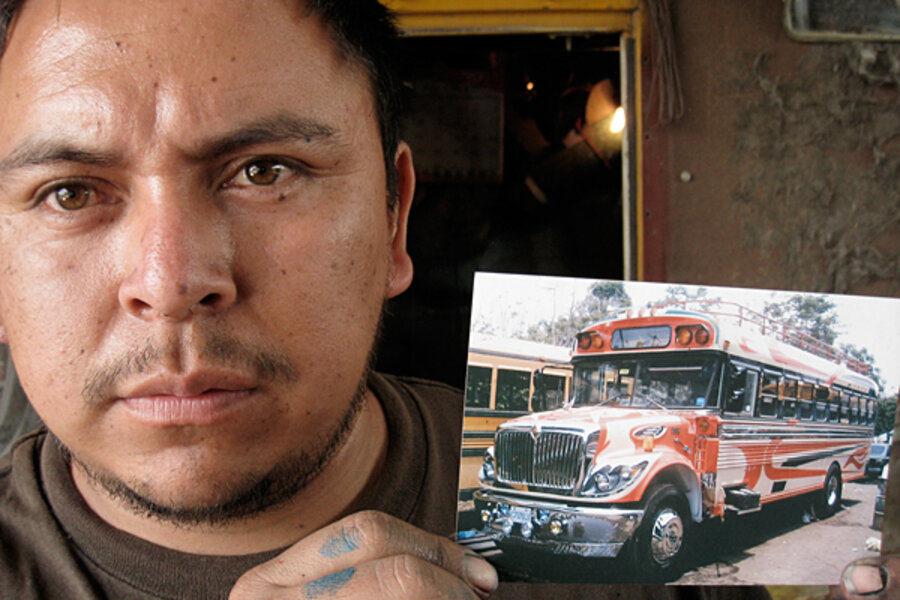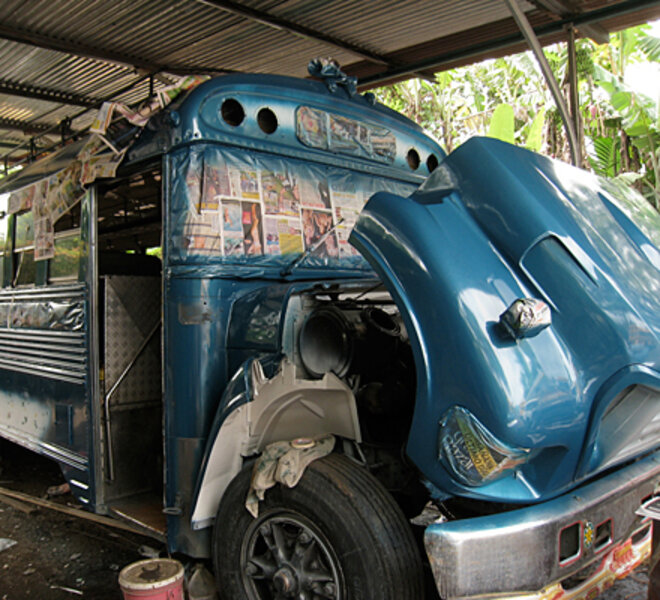Once a US school bus, now a Central American taxi
Loading...
| San Salvador, El Salvador; and Ciudad Vieja, Guatemala
Students across the United States are climbing onto the iconic yellow school buses rolling through subdivisions and down city streets this week as the school year kicks off.
But hundreds of miles away in Central America, school buses “retired” from their scholastic routes in the US go on to jam-packed second lives.
“We reuse them until they’re dead,” says Fredys Aguilar, a Salvadoran businessman who has been importing American school buses for more than 20 years.
From El Salvador to Guatemala, from Nicaragua to Honduras, former US school buses take on a new life shuttling people – often packed tight – across cities big and small. In some places, like Guatemala, there’s an impressive art that goes into refurbishing the vehicles.
Nearly everywhere there are threats of collisions as the oversized buses scream down main throughways. Meanwhile, an increasing fear of armed robbery and murders has swept the region, threatening drivers and passengers alike. Buses are easy targets for extortion and robbery because they are always transporting cash.
A few times a year, Mr. Aguilar, owner of FA Imports, travels to the United States with three or four men to pick up buses he’s purchased online and drive them back to San Salvador. It’s roughly an 8-day trip from Boston, Mass., and requires a long, and at times risky, drive through Mexico and Guatemala.
“We call it the yellow hotel,” because the men spend the entire trip eating and sleeping on the bus, says Aguilar. He likes the US leg of the trip where, for every 50 gallons of gas he buys, most truck stops offer free showers for his drivers. He pays his men around $800 per trip (in addition to a plane ticket to the US and meals on the road), a hefty sum in a country where the minimum wage is $225 per month.
Aguilar says he’s stopped driving buses back to El Salvador himself. “It’s become too dangerous,” he says, citing the potential for kidnappings and extortion. His drivers travel in a caravan in hopes of staving off any attacks.
In the past couple of years Aguilar has bought buses from Massachusetts, New York, New Hampshire, and Maine.
He prefers East Coast buses because they’re typically cheaper. “They’re all rusted,” he says, citing hard winters and corrosive ice-melt. California buses? “Those are untouchable,” Aguilar says.
Full-body makeover
In neighboring Guatemala, old US school buses blinged out with flashing lights, bouncing stereo systems, and intricate paint jobs vie to pick up the most passengers along their routes.
“The more people you fit and the faster you drive, the more money you make,” says José Nevado, who refurbishes US school buses but doesn’t drive them. “Some people will wait for a better looking bus,” because they think they’ll be safer, or at least more comfortable, he says.
Between tourist-haven Antigua and downtown Guatemala City, drivers’ assistants lean precariously out bus doors calling, “Guate, Guate, Guate,” shorthand for the capital city. The assistants, typically young boys, squeeze through the strikingly tight aisles to collect a roughly $0.20 fare from passengers squished three to a seat.
When the yellow buses plastered with US district names like Atlanta Public Schools and Genesee Valley arrive in Guatemala, most head to the small town of Ciudad Vieja, once Guatemala’s capital. Here, they undergo strategic and superficial transformations: Specialized workshops install longer seats (US buses are designed to seat two per bench) and often shorten buses so they can fly through the sharp turns on twisting back roads.
The small town, a short ride from Antigua’s cobblestone streets, has two main industries – refurbishing buses and building coffins.
It’s a morbid juxtaposition, but highlights the increasing risk of working as a driver here. In Guatemala, more than 1,000 bus, taxi, and truck drivers were murdered between 2006 and 2012, according to the National Transportation Coordinator, making transportation work one of the most perilous careers in the country.
Some workshops, like Reconstructora de Buses Figueroa, go the extra mile to add details that will appeal to passengers. They have a machine to stamp the ever-desirable “Blue Bird” bus company name onto replacement parts, for example.
The Georgia-based Blue Bird Corporation has built buses since 1927.
“Here, Blue Bird is the most famous and the highest quality bus,” says Julio Cesar Figueroa, co-owner of the workshop.
Down the road, Mr. Nevado stands in his small outdoor workshop covered in paint. He fixes everything: Totaled buses, finicky engines, and vehicles in need of bells and whistles like luggage racks and casino-style blinking signage.
Dressed in tattered jeans and a t-shirt, Nevado says his favorite jobs call for painting.
“There are some people who come in with really specific taste,” he says. A big business might ask for the entire fleet to use the same color combination. Others leave it up to Nevado to make the call. He keeps a pile of photos highlighting some of his finest work, including an orange, black, and white paint job he calls a favorite.
On a recent visit, there were four buses in his yard. One, partially painted blue, has newspaper taped over its windows and headlights. His team has already shortened the bus from 11 to 9 rows and replaced the hood of the vehicle “so that it will look like a real firecracker,” says Nevado.
“A complete change,” he says.
As the bus undergoes its transformation, a small plaque bolted next to the driver’s seat hints at the vehicles rich history on the roads. “BLUE BIRD EAST,” it reads noting a capacity of 65. “MODEL YR: 1983.”
- The reporter's travel to El Salvador was made possible by the International Center For Journalists.







